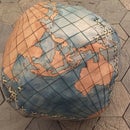Introduction: Space Station Shop Apron
I want to dress like a distant landscape at all times - working in the shop is no exception. With full colour digital printing easily accessible, I like to create clothing and accessories covered in prints.
This print is of a painting Nasa commissioned in the 1970's while they were exploring the possibilities of creating human settlements in space. I am interested in science fiction and science fiction aesthetics that extend beyond the typical techno-mechanical-macho futurism - and I think these paintings capture a different kind of imagined future. Sublime yet urban, they hint at the awe we might experience every day living in space.
All that to say - I thought this was a cool thing to print on an apron, and maybe you will too.
Step 1: Design Your Apron Profile
Using Fusion 360's sketch function, I drew out a profile for an apron pattern. I included a couple pockets, and exported the geometry as a DXF.
You can learn more about sketching in Fusion here.
Step 2: Find an Image
Nasa uploads hundreds of high quality images onto their Flickr page under Creative Commons licenses. When I am in need of an interesting image to include in something I am working on, this is always a good place to start.
I found this image in an album of the space colony artwork from the 1970's.
This painting is called Cylinder Eclipse, and shows an eclipse of the sun with view of clouds and vegetation.
Art work: Don Davis. Credit: NASA Ames Research Center
Step 3: Combine in Illustrator
I brought the DXFs from Fusion into Adobe Illustrator so I could add the art work. The vectors from Fusion didn't come in as a closed polyline, so I had to use the join tool in Illustrator to create closed profiles.
Ensure that your pattern is the right size before you import your artwork.
I arranged all of my pieces, and added dotted lines so I know where my seam allowance starts.
Using the clipping mask tool, all of the artwork that isn't contained in my apron pattern is hidden. I repeated the clipping mask for each of my two pockets.
Step 4: Paper Prototype
I printed a paper prototype to test the size of my pattern. If you don't have access to a large format printer, there are ways to print large patterns at home.
Step 5: Printing
I have access to a Roland Versacamm Vinyl Printer, which can also print on canvas. The canvas it uses is pretty stiff, so if I was to do this again I would order fabric from Spoonflower.
From my paper prototype, I removed 6 inches of material at the bottom. I also did a small test print, and lightened the print quite a bit.
Attachments
Step 6: Construction
I included dotted lines in the pattern so registering the pockets was a little easier. Both pockets are patch pockets, so you fold in the seam allowance and sew them in place. The entire perimeter was hemmed, and I clipped the seam allowance at the curves to get a flat seam.
I found some leather straps that I riveted in place to finish the piece off.
Step 7: Files!
Here are all the files I used to make this apron. Have fun!







